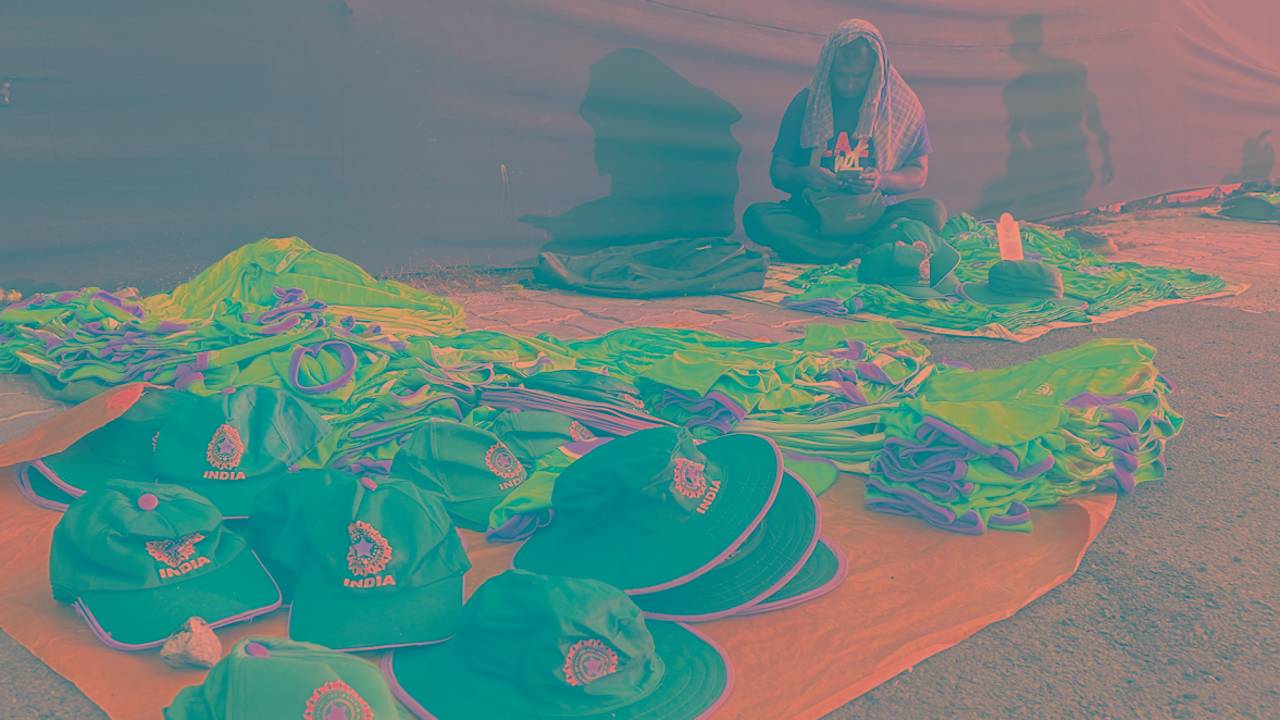The unsung heroes behind India's spectacular stadium atmosphere
While some labour alongside families, others embark on epic journeys to fuel the fervor of the World Cup
Daya Sagar
29-Oct-2023
Meet Swadesh Shekhar Haldar, a 46-year-old resident of Dum Dum area in Kolkata, on his second World Cup journey. Back in 2011, the last time when the tournament was held in the Indian subcontinent, Haldar had visited every city in India which hosted their matches. He isn't a massive fan of the game, and has never witnessed any action from inside a stadium; but he's the man behind the vibrant jerseys, flags, whistles and caps sold just outside, things which make the atmosphere so lively.
Over the past 25 days, Haldar has travelled roughly 6750kms - from Chennai to Lucknow via Delhi. This cricketing journey had began on October 3, and he has been on a national tour ever since. Moreover, before the World Cup final is held in Ahmedabad, he will have added another 3000kms to his journey.
Haldar had commenced his World Cup preparations three months in advance, reserving railway tickets for each city where India were scheduled to play. Hence, so far he has been to Chennai, Ahmedabad, Pune, and Lucknow; next in line are Kolkata, Mumbai and Bengaluru. Should India advance to the semi-final and the final, Haldar is all set to retrace his steps to Mumbai and Ahmedabad, for which he has already made reservations.

A common scene outside the Ekana Cricket Stadium•Daya Sagar/ESPNcricinfo Ltd
Although not a fervent cricket enthusiast, Haldar had started with selling flags and caps way back in 1998. It was only since the 2011 World Cup that he began selling player-themed jerseys with player names and numbers.
"Previously it was mostly flags, headbands and caps which dominated sales, but now it's the T-shirts that have taken the lead," he said. "Our goal is to sell about 150 T-shirts in each city, although we sometimes manage to sell only 100-120."
The bestselling T-shirt? It's Virat Kohli's, followed closely by those of Rohit Sharma, MS Dhoni, Suryakumar Yadav, and Shubman Gill. Interestingly, though, people these days are more frugal with their spending. Earlier, they'd readily part with 400-500 rupees for a T-shirt, but now, even shelling out 200-250 rupees feels like a hefty investment, resulting in thinner profit margins.

Virat Kohli T-shirts comfortably sell the most in India, followed by Rohit Sharma and MS Dhoni's•Daya Sagar/ESPNcricinfo Ltd
Paritosh Roy, another T-shirt vendor, underscores the challenges and devotion that define their unique trade. He tells us, "Virat Kohli's T-shirt leads the sales, trailed by those of Rohit Sharma, MS Dhoni, Suryakumar Yadav and Shubman Gill. But earlier, individuals didn't hesitate to pay Rs 400-500 for a T-shirt; now even Rs 200-250 seems like a steep price, thus affecting our profitability. However, we've been in this business for several years, so there's no room for others to take the risk of starting something new."
During the off-season, Roy switches to selling fish in Kolkata, while Haldar sells fruits on the city's streets. For those hailing from far-flung places, there lies the challenge of finding accommodations: some opt to rent rooms in small hotels or lodges close to the stadium, while others prefer the open sidewalk, thus trying to maximise profits.
Umesh Kale, a 38-year-old vendor from Mumbai, says, "Staying in a hotel and dining out is impractical. After all the hard work, what's the point if we don't turn a profit? That's why we sleep on the stadium's sidewalk, and use utensils to prepare our meals."
Kale isn't alone in this venture; he is accompanied by his mother, brother, sister-in-law and a young daughter. With an abundance of T-shirts to sell, both brothers set up their separate stalls; his mother and sister-in-law, meanwhile, prepare meals in the vicinity.
Kale mentions that he has been part of this trade for two decades. He has been there in every IPL season too since 2008, except for the Covid-19-affected years. During the cricket off-season, he expands his horizons by traveling to different cities for selling hockey and football merchandise, particularly of the Indian Super League.
****
Raja Mandal's train arrives in Lucknow early in the morning. As it was the day before the match, he grabbed a quick breakfast at the station and then headed to the stadium. However, he didn't eat anything else until late in the evening due to the lack of affordable dining options near the stadium. Even the street vendors with snacks and samosas were relocated by the police. Thus, Mandal relies on nearby sidewalk vendors serving patties to satiate his hunger.
Mandal says, "This work is filled with hardships, and demands extensive travel. When we travel by train, we face challenges from the police because of our large bag of merchandise. Besides, the police near the stadium also constantly move our stalls around. Furthermore, you can only find a proper meal at night; during the day, you have to suffice with patties and samosas."
Despite the challenges, Mandal finds immense joy in his work, driven by his deep love for cricket. He takes pride in his connection to the sport, however indirect it may be.
A version of this piece was published first on the ESPNcricinfo Hindi website here.
Daya Sagar is sub editor in ESPNcricinfo Hindi @sagarqinare
